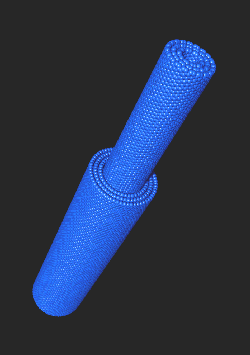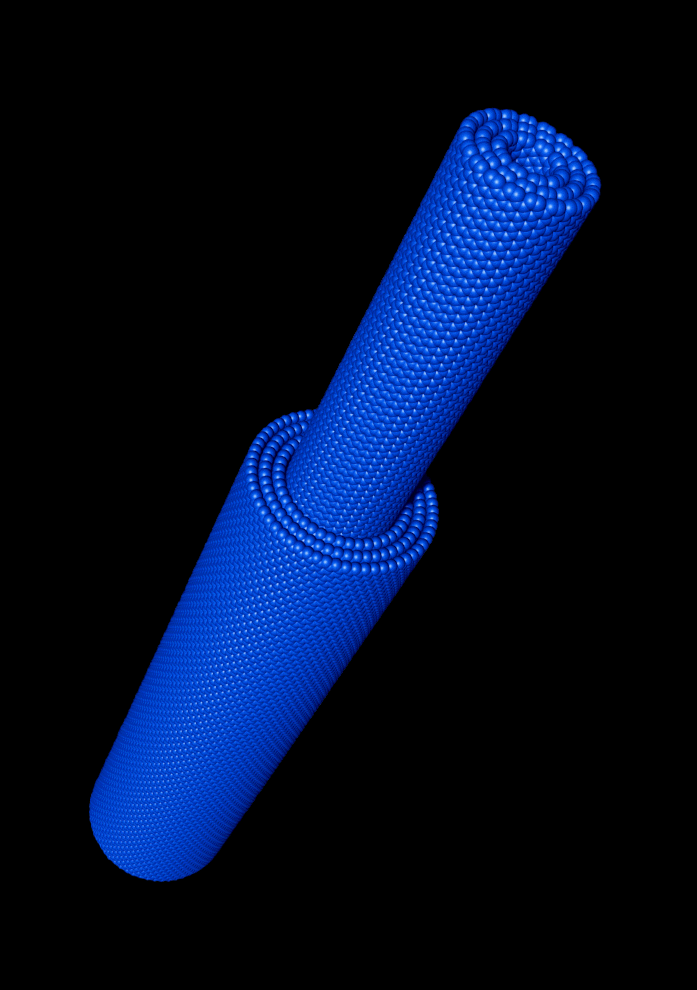Nanotubes in the Fast Lane
If engineers want to build nanoscale machines with moving parts that can generate and respond to electronic signals, those parts have got to be lightning fast. The quickest draw so far in the frontier world of micro-machinery is the nanotube–a light, strong cylinder of hexagonally arrayed carbon. In the 28 January print issue of PRL, researchers calculate that a group of concentric nanotubes nested inside an outer set of tubes can slide back and forth a billion times every second. Such a gigahertz oscillator could be a major advance in nanotechnology that would enable applications such as ultra-fast optical filters and nano-antennae.
Nanotubes form naturally in multiple concentric tubes (“multi-walled” nanotubes) with closed ends that are just nanometers in diameter. In 2000, John Cumings and Alex Zettl of the University of California (UC) at Berkeley showed that after peeling open one end of a multiwalled tube, the inner tubes could slide in and out with very low friction [1]. That’s just what researchers want for the mechanical parts of nanoscale machines. The experiments also demonstrated that the so-called van der Waals force, which attracts all neutral atoms to one another, caused the inner nanotubes to be pulled back inside the sheath of outer tubes.
Mechanical engineers Quanshui Zheng of Tsinghua University in Beijing and Qing Jiang of the UC Riverside campus imagined what would happen if both ends of the original capsule had been peeled away. In their PRL paper, they show theoretically that after the inner core is pulled out and released, it should fly straight through and back out the other side. The low friction between tubes–a tenth or less of the nano-newton-scale attractive force–allows the ensuing oscillation to match a Pentium 4 computer chip’s speed in processing electronic signals. “It has been a dream for decades to reach [these speeds],” Jiang says. “This demonstrates the feasibility of fabricating such devices.”
One potential use for the speedy nanotubes is an optical filter for fiberoptic systems. A beam of light would be blocked or allowed to pass depending on whether the inner core was extended or retracted. To move the tube in and out, charged chemical dopants might be added that would respond to the charge on a nearby electrode, says Jiang, who adds that driving the devices and connecting them to other components are key challenges. Multiwalled tubes could also be used as receivers sensitive to high frequency electromagnetic signals, sliding to and fro in time to the incoming wave.
“This charming thought of a wildly oscillating tube poses some rigorous challenges for experimentalists,” notes Vincent Crespi of Pennsylvania State University in University Park, particularly in how to eliminate imperfections and minimize what little friction exists. It’s a nice idea that might just work, adds Zettl. “It’s a little bit far out,” he says; but the physics is right, and nanotubes are already known to do impressive things. In fact, he expects many more mechanical feats from nanotubes in the future. “This is the first of many such ideas that will come along,” he predicts.
–JR Minkel
JR Minkel is a freelance science writer in New York City.
References
- J. Cumings and A. Zettl, Science 289, 602 (2000)
More Information
W. Guo et al., “Energy Dissipation in Gigahertz Oscillators from Multiwalled Carbon Nanotubes,” Phys. Rev. Lett. 91, 125501 (2003)





